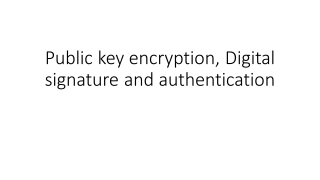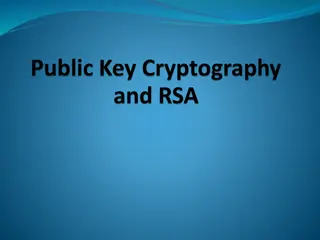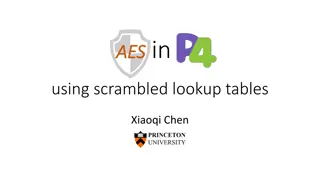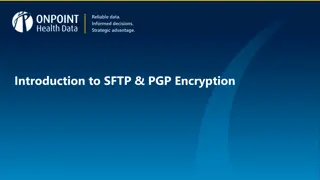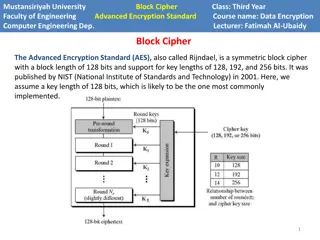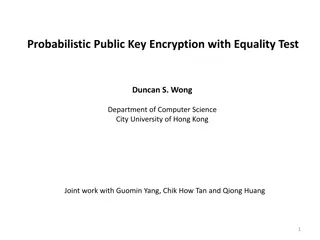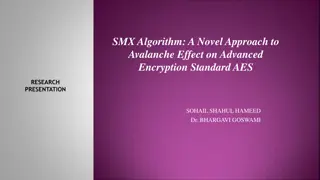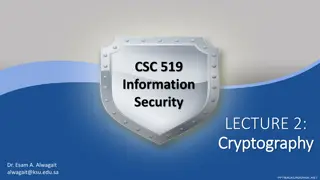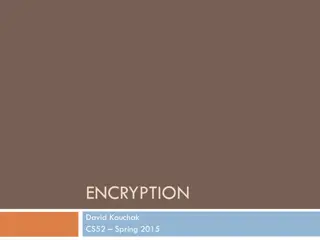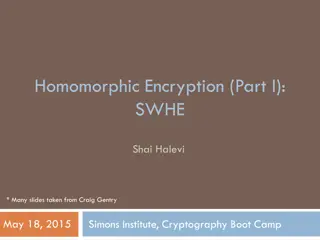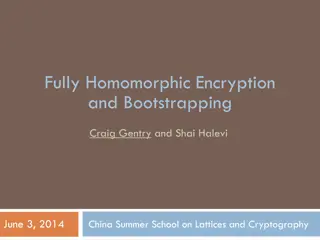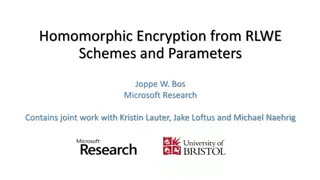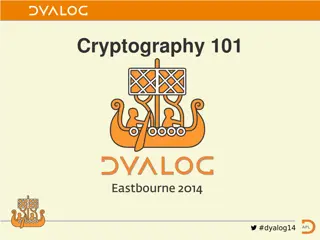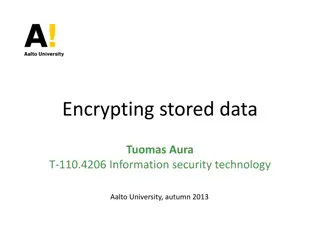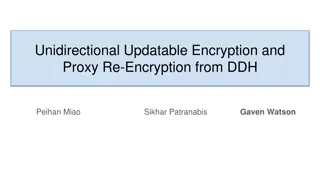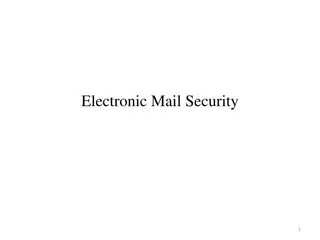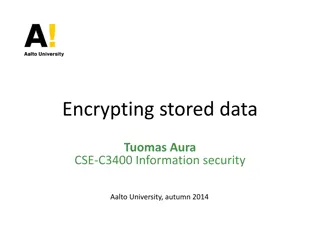ENCRYPTION TAKE 2: PRACTICAL DETAILS
This content delves into practical aspects of encryption, focusing on topics such as RSA public key encryption, encryption cracking methods, and the security of RSA. It covers fundamental concepts, algorithms, and strategies related to encryption and decryption, providing insights into how encryption works and how it can be potentially cracked. With detailed explanations and illustrations, this resource offers a comprehensive overview of encryption techniques and their application.
Download Presentation

Please find below an Image/Link to download the presentation.
The content on the website is provided AS IS for your information and personal use only. It may not be sold, licensed, or shared on other websites without obtaining consent from the author.If you encounter any issues during the download, it is possible that the publisher has removed the file from their server.
You are allowed to download the files provided on this website for personal or commercial use, subject to the condition that they are used lawfully. All files are the property of their respective owners.
The content on the website is provided AS IS for your information and personal use only. It may not be sold, licensed, or shared on other websites without obtaining consent from the author.
E N D
Presentation Transcript
ENCRYPTION TAKE 2: PRACTICAL DETAILS David Kauchak CS52 Spring 2016
Admin Assignment 6 Assignment 7
Public key encryption I like bananas I like bananas decrypt message encrypt message send encrypted message
RSA public key encryption Choose a bit-length k 1. Choose two primes p and q which can be represented with at most k bits 2. Let n = pq and (n) = (p-1)(q-1) 3. Find d such that 0 < d < n and gcd(d, (n)) = 1 4. Find e such that de mod (n) = 1 5. private key = (d,n) and public key = (e, n) 6. encrypt(m) = me mod n decrypt(z) = zd mod n 7.
Cracking RSA Choose a bit-length k 1. Choose two primes p and q which can be represented with at most k bits 2. Let n = pq and (n) = (p-1)(q-1) 3. Find d such that 0 < d < n and gcd(d, (n)) = 1 4. Find e such that de mod (n) = 1 5. private key = (d,n) and public key = (e, n) 6. encrypt(m) = me mod n decrypt(z) = zd mod n 7. Say I maliciously intercept an encrypted message. How could I decrypt it? (Note, you can also assume that we have the public key (e, n).)
Cracking RSA encrypt(m) = me mod n Idea 1: undo the mod operation , i.e. mod-1 function If we knew me and e, we could figure out m Do you think this is possible?
Cracking RSA encrypt(m) = me mod n Idea 1: undo the mod operation , i.e. mod-1 function If we knew me and e, we could figure out m Generally, no, if we don t know anything about the message. The challenge is that the mod operator maps many, many numbers to a single value.
Security of RSA (n) = (p-1)(q-1) d: 0 < d < n and gcd(d, (n)) = 1 e: de mod (n) = 1 p: prime number q: prime number n = pq (d, n) (e, n) private key public key Assuming you can t break the encryption itself (i.e. you cannot decrypt an encrypted message without the private key) How else might you try and figure out the encrypted message?
Security of RSA (n) = (p-1)(q-1) d: 0 < d < n and gcd(d, (n)) = 1 e: de mod (n) = 1 p: prime number q: prime number n = pq (d, n) (e, n) private key public key Assuming you can t break the encryption itself (i.e. you cannot decrypt an encrypted message without the private key) Idea 2: Try and figure out the private key! How would you do this?
Security of RSA (n) = (p-1)(q-1) d: 0 < d < n and gcd(d, (n)) = 1 e: de mod (n) = 1 p: prime number q: prime number n = pq (d, n) (e, n) private key public key Already know e and n. If we could figure out p and q, then we could figure out the rest (i.e. d)!
Security of RSA (n) = (p-1)(q-1) d: 0 < d < n and gcd(d, (n)) = 1 e: de mod (n) = 1 p: prime number q: prime number n = pq (d, n) (e, n) private key public key How would you do figure out p and q?
Security of RSA (n) = (p-1)(q-1) d: 0 < d < n and gcd(d, (n)) = 1 e: de mod (n) = 1 p: prime number q: prime number n = pq (d, n) (e, n) private key public key For every prime p (2, 3, 5, 7 ): - If n mod p = 0 then q = n / p Why do we know that this must be p and q?
Security of RSA (n) = (p-1)(q-1) d: 0 < d < n and gcd(d, (n)) = 1 e: de mod (n) = 1 p: prime number q: prime number n = pq (d, n) (e, n) private key public key For every prime p (2, 3, 5, 7 ): - If n mod p = 0 then q = n / p Since p and q are both prime, there are no other numbers that divide them evenly, therefore no other numbers divide n evenly
Security of RSA (n) = (p-1)(q-1) d: 0 < d < n and gcd(d, (n)) = 1 e: de mod (n) = 1 p: prime number q: prime number n = pq (d, n) (e, n) private key public key For every number p (2, 3, 4, 5, 6, 7 ): - If n mod p = 0 then q = n / p How long does this take? I.e. how many p do we need to check in the worst case assuming n has k bits?
Security of RSA (n) = (p-1)(q-1) d: 0 < d < n and gcd(d, (n)) = 1 e: de mod (n) = 1 p: prime number q: prime number n = pq (d, n) (e, n) private key public key For every number p (2, 3, 4, 5, 6, 7 ): - If n mod p = 0 then q = n / p - - - p is at most k bits With k bits we can represent numbers up to 2k If we assumed that p was picked randomly from these numbers, then on average we d have to check 2k-1 numbers (half of them) For large k (e.g. 1024) this is a very big number! -
Security of RSA (n) = (p-1)(q-1) d: 0 < d < n and gcd(d, (n)) = 1 e: de mod (n) = 1 p: prime number q: prime number n = pq (d, n) (e, n) private key public key For every number p (2, 3, 4, 5, 6, 7 ): - If n mod p = 0 then q = n / p Currently, there are no known efficient methods for factoring a number into it s primes. This is the key to why RSA works!
Implementing RSA Choose a bit-length k 1. For generating the keys, this is the only input the algorithm has
Implementing RSA Choose two primes p and q which can be represented with at most k bits 2. Ideas?
Finding primes Choose two primes p and q which can be represented with at most k bits 2. Idea: pick a random number and see if it s prime How do we check if a number is prime?
Finding primes Choose two primes p and q which can be represented with at most k bits 2. Idea: pick a random number and see if it s prime isPrime(num): for i = 2 sqrt(num): if num % i == 0: return false return true If the number is k bits, how many numbers (worst case) might we need to examine?
Finding primes Choose two primes p and q which can be represented with at most k bits 2. Idea: pick a random number and see if it s prime - Again: with k bits we can represent numbers up to 2k - Counting up to sqrt = (2k)1/2 = 2k/2
Finding primes Primality test for num: - pick a random number a - perform test(num, a) - if test fails, num is not prime - if test passes, 50% chance that num is prime Does this help us?
Finding primes Primality test for num: - pick a random number a - perform test(num, a) - if test fails: return false - if test passes: return true If num is not prime, what is the probability (chance) that we incorrectly say num is a prime?
Finding primes Primality test for num: - pick a random number a - perform test(num, a) - if test fails: return false - if test passes: return true 0.5 (50%) Can we do any better?
Finding primes Primality test for num: - Repeat 2 times: - pick a random number a - perform test(num, a) - if test fails: return false - return true If num is not prime, what is the probability that we incorrectly say num is a prime?
Finding primes Primality test for num: - Repeat 2 times: - pick a random number a - perform test(num, a) - if test fails: return false - return true p(0.25) Half the time we catch it on the first test Of the remaining half, again, half (i.e. a quarter total) we catch it on the second test we don t catch it
Finding primes Primality test for num: - Repeat 3 times: - pick a random number a - perform test(num, a) - if test fails: return false - return true If num is not prime, what is the probability that we incorrectly say num is a prime?
Finding primes Primality test for num: - Repeat 3 times: - pick a random number a - perform test(num, a) - if test fails: return false - return true p(1/8)
Finding primes Primality test for num: - Repeat m times: - pick a random number a - perform test(num, a) - if test fails: return false - return true If num is not prime, what is the probability that we incorrectly say num is a prime?
Finding primes Primality test for num: - Repeat m times: - pick a random number a - perform test(num, a) - if test fails: return false - return true p(1/2m) For example, m = 20: p(1/220) = p(1/1,000,000)
Finding primes Primality test for num: - Repeat m times: - pick a random number a - perform test(num, a) - if test fails: return false - return true Fermat s little theorem: If p is a prime number, then for all integers a: a ap(mod p) How does this help us?
Finding primes Fermat s little theorem: If p is a prime number, then for all integers a: a ap(mod p) test(num, a): - generate a random number a < p - check if ap mod p = a
Implementing RSA Choose a bit-length k 1. Choose two primes p and q which can be represented with at most k bits 2. Let n = pq and (n) = (p-1)(q-1) 3. How do we do this?
Implementing RSA Find d such that 0 < d < n and gcd(d, (n)) = 1 4. Find e such that de mod (n) = 1 5. How do we do these steps?
Greatest Common Divisor A useful property: If two numbers are relatively prime (i.e. gcd(a,b) = 1), then there exists a c such that a*c mod b = 1
Greatest Common Divisor A more useful property: two numbers are relatively prime (i.e. gcd(a,b) = 1) iff there exists a c such that a*c mod b = 1 What does iff mean?
Greatest Common Divisor A more useful property: If two numbers are relatively prime (i.e. gcd(a,b) = 1), then there exists a c such that a*c mod b = 1 1. If there exists a c such that a*c mod b = 1, then the two numbers are relatively prime (i.e. gcd(a,b) = 1) 2. We re going to leverage this second part
Implementing RSA Find d such that 0 < d < n and gcd(d, (n)) = 1 4. Find e such that de mod (n) = 1 5. If there exists a c such that a*c mod b = 1, then the two numbers are relatively prime (i.e. gcd(a,b) = 1) To find d and e: - pick a random d, 0 < d < n - try and find an e such that de mod (n) = 1 - if none exists, try another d - if one exists, we re done!
Known problem with known solutions For the assignment, I ve provided you with a function: inversemod
Option type Look at option.sml http://www.cs.pomona.edu/~dkauchak/classes/cs52 /examples/option.sml option type has two constructors: - NONE (representing no value) - SOME v (representing the value v)
case statement case _______ of pattern1 => value | pattern2 => value | pattern3 => value
Signing documents If a message is encrypted with the private key how can it be decrypted? I like bananas encrypt message Hint: - (me)d = med = m (mod n) - encrypt(m, (e, n)) = me mod n - decrypt(z, (d, n)) = zd mod n
Signing documents (me)d = med = m (mod n) encrypt(m, (e, n)) = me mod n decrypt(z, (d, n)) = zd mod n - - - encrypt(m, (d,n)) = md mod n decrypt( md mod n , (e, n)) = (md)e mod n = mde mod n = med mod n = m (if m < n)
Signing documents I like bananas encrypt message What does this do for us?
Signing documents I like bananas If the message can be decrypted with the public key then the sender must have had the private key encrypt message This is a way to digitally sign a document!
Signing documents Confirmed: batman likes bananas I like bananas I like bananas encrypt message decrypt message send signed message
Signing documents Confirmed: batman likes bananas I like bananas I like bananas encrypt message decrypt message send signed message
Public key encryption Share your public key with everyone How does this happen? Anything we have to be careful of?


